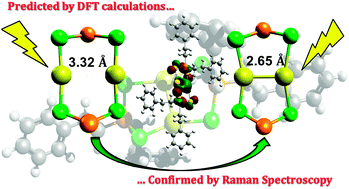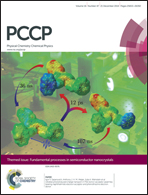Au–Au chemical bonding induced by UV irradiation of dinuclear gold(i) complexes: a computational study with experimental evidence†
Abstract
Two luminescent dinuclear gold(I) species, namely diselenophosphinate [Au2{μ-Se2P((CH2)2Ph)2}2] and dithiophosphinate [Au2{μ-S2P((CH2)2Ph)2}2], exhibiting interesting structural, absorption and emission properties have been studied. In the solid state, both complexes exist in a dinuclear monomeric form, exhibiting no aurophilic interaction, and display similar photophysical properties. It is shown, using DFT computations, that Au–Au chemical bonding appears in the first excited state of these complexes, whereas such bonding does not exist in their ground state; Raman spectroscopy experiments, which bring to light the stretching of this new bond, confirm the theoretical results. Moreover, TDDFT computations permitted us to assign the observed absorption bands of the UV-visible spectra of the two species to LMCT transitions and to describe the emission.


 Please wait while we load your content...
Please wait while we load your content...